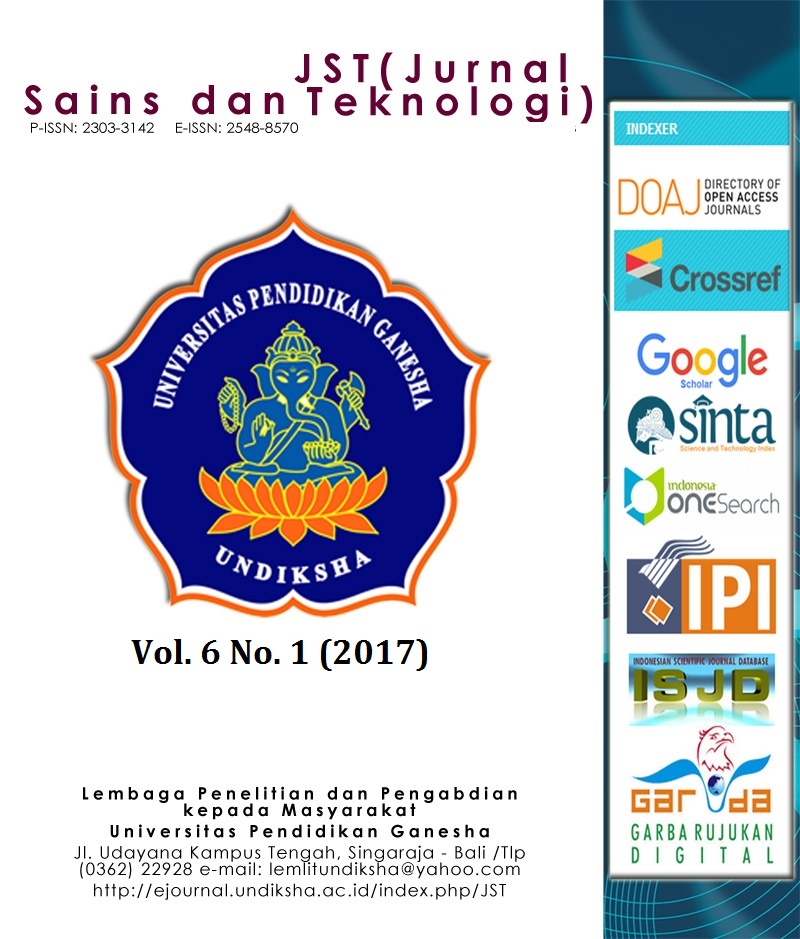ADSORPSI ION EMAS MENGGUNAKAN ASAM HUMAT TANAH GAMBUT DI BAWAH RADIASI SINAR UV
DOI:
https://doi.org/10.23887/jstundiksha.v6i1.9179Kata Kunci:
Adsorpsi reduktif, asam humat, ion Au(III), sinar UVAbstrak
Berbagai upaya dapat dilakukan untuk mendulang kembali (recovery) emas dari limbah elektronik, salah satunya adalah melalui proses adsorpsi. Salah satu adsorben yang dapat digunakan untuk proses adsorpsi ion emas di dalam larutan adalah asam humat (AH) hasil isolasi dari tanah gambut. Proses adsorpsi ion emas menggunakan AH tanah gambut diikuti dengan proses reduksi ion emas menjadi logam emas. Proses adsorpsi reduktif ini dapat ditingkatkan dengan penyinaran menggunakan sinar UV. Penelitian ini bertujuan untuk mempelajari proses adsorpsi ion emas menggunakan asam humat tanah gambut dengan adanya radiasi sinar UV. Proses adsorpsi ion emas dilakukan dengan metode batch dan parameter yang dipelajari antara lain pH, waktu interaksi, serta variasi konsentrasi ion emas dalam larutan. pH optimum proses adsorpsi adalah 2. Proses adsorpsi ion emas pada AH tanah gambut di bawah radiasi UV mengikuti model kinetika adsorpsi yang diajukan oleh Santosa (2007) serta mengikuti model isotermal adsorpsi Langmuir. Radiasi sinar UV dapat membuat proses adsorpsi reduktif ion emas menggunakan AH tanah gambut menjadi lebih efektif. Kapasitas adsorpsi ion emas pada AH tanah gambut adalah 90,91 mg/g. Penambahan 2-propanol akan menurunkan efektivitas proses adsorpsi ion emas pada AH tanah gambut.
Referensi
Lestari, P. (2017). Isolation of Humic Acid from Peat Soil and Its Application as an Adsorbent for AuCl4- in Solution. AIP Conference Proceedings 1823. Yogyakarta.
Manahan, S. (2000). Environmental Chemistry, 7th edition. Florida: Lewish Publishers.
Nakajima, A., Ohe, K., Baba, Y., & Kijima, T. (2003). Mechanism of Gold Adsorption by Persimmon Tannin Gel. Analytical Sci., 1075-1077.
Ogata, T., & Nakano, Y. (2005). Mechanisms of Gold Recovery from Aqueous Solutions Using a Novel Tannin Gel Adsorbent Synthesized from Natural Condensed Tannin. Water Resources, 4281-4286.
Paclawski, K., & Fitzner, K. (2004). Kinetics of Gold(III) Chloride Complex Reduction Using Sulfur(IV). Metall. Mat.Trans. B., 35; 1071-1085.
Paclawski, K., & Sak, T. (2015). Kinetics and Mechanism of the Reaction of Gold(III) Chloride Complexes with Formic Acid. J. Min. Metall. Sect. B-Metall. 51, 133 – 142 . J. Min. Metall. Sect. B-Metall., 133 – 142 .
Parajuli, D., Adhikari, C., Kuriyama, M., Kawakita, H., Ohto, K., Inoue, K., et al. (2006). Selective Recovery of Gold by Novel Lignin-Based Adsorption Gel. Ind. Eng. Chem. Res., 8-14.
Polewski, K., Slawińska, D., Slawiński, J., & Pawlak, A. (2005). The Effect Of UV and Visible Light Radiation On Natural Humic Acid EPR Spectra and Kinetic Studies. Geoderma, 291-299.
Rochat, D., Hageluken, C., Keller, M., & Widmer, R. (2007). Optimal Recycling for Printed Wiring Boards (PWBs) in India. Proceeding of the R’07 World Congress Recovery of Materials and Energy for Resources Efficiency. Davos, Switzerland.
Santosa, S., Siswanta, D., Kurniawan, A., & Rahmanto, W. (2007). Hybrid of Chitin and Humic Acid as High Performance Sorbent for Ni(II). Surface Sci., 5155-5161.
Stevenson, F. (1994). Humus Chemistry: Genesis, Compositions, Reactions. New York: John Wiley & Sons Inc. .
Stumm, W., & Morgan, J. (1996). Aquatic Chemistry: Chemical Equilibria and Rates in Natural Waters. 3rd edition. New York: John Wiley & Sons Inc.
Torre, M., Bachiller, D., Rendueles, M., Menendez, C., & Diaz, M. (2006). Cyanide Recovery from Gold Extraction Process Waste Effluents by Ion Exchange I.Equilibrium and Kinetics. Solvent Extr. Ion Exch. , 99-117.
Wang, S., Qian, K., Bi, X., & Huang, W. (2009). Influence of Speciation of Aqueous HAuCl4 on the Synthesis, Structure, and Property of Au Colloids . J. Phys. Chem. C. , 6505-6510.
Unduhan
Diterbitkan
Cara Mengutip
Terbitan
Bagian
Lisensi
Authors who publish with the Jurnal Sains dan Teknologi (JST) agree to the following terms:
- Authors retain copyright and grant the journal the right of first publication with the work simultaneously licensed under a Creative Commons Attribution License (CC BY-SA 4.0) that allows others to share the work with an acknowledgment of the work's authorship and initial publication in this journal.
- Authors are able to enter into separate, additional contractual arrangements for the non-exclusive distribution of the journal's published version of the work (e.g., post it to an institutional repository or publish it in a book), with an acknowledgment of its initial publication in this journal.
- Authors are permitted and encouraged to post their work online (e.g., in institutional repositories or on their website) prior to and during the submission process, as it can lead to productive exchanges, as well as earlier and greater citation of published work. (See The Effect of Open Access)
















